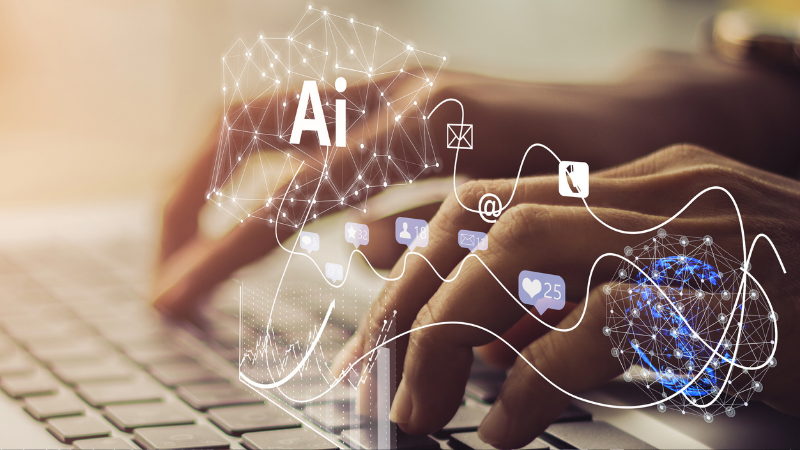Artificial intelligence (AI) has become a part of our daily lives in more ways than you might think! In this article we talk about the examples of AI in everyday life, provide benefits and drawbacks of it, also you’ll get some tips.
Real life Examples of Artificial Intelligence
Morning
- Smart Alarm: Your alarm clock gradually increases light and sound to mimic a natural sunrise, making waking up more gentle. AI personalizes the wake-up experience based on data.
- Coffee Machine: You tell your smart coffee maker to start brewing a pot while you shower, and it adjusts brewing based on your preferences and the day’s schedule. AI learns your habits and automates tasks.
- News Briefing: A smart speaker summarizes the news while you get ready, tailoring the content to your interests. AI curates information based on your preferences.
Commuting
- Navigation App: As you drive, your navigation app suggests the fastest route based on real-time traffic data and your usual travel patterns. AI analyzes vast amounts of data to optimize your journey.
- Public Transportation: You use a ride-sharing app that matches you with a driver or predicts bus arrival times using AI algorithms. AI helps you travel efficiently and conveniently.
- Entertainment: You listen to music recommendations on your streaming service, curated by AI based on your listening history and similar users’ preferences. AI examples in real life include virtual assistants like Siri and Alexa, recommendation systems such as those used by Netflix and Amazon.
Work
- Email Spam Filter: Your email provider uses AI to identify and block spam messages before they reach your inbox. AI protects you from unwanted emails and keeps your inbox organized.
- Translation Tools: While collaborating with international colleagues, you use AI-powered translation tools to communicate effectively despite language barriers. AI breaks down language barriers and fosters collaboration.
- Chatbots: You interact with a chatbot on your company’s website to get quick answers to simple questions, saving you time and effort. AI automates basic tasks and improves customer service.
Leisure
- Social Media Feeds: Social media platforms use AI algorithms to personalize your feed, showing you content you’re more likely to engage with. AI tailors your online experience to your interests.
- Streaming Services: When you watch a movie, AI recommendations suggest similar titles you might enjoy based on your watch history and user trends. AI helps you discover new content you’ll love.
- Fitness Trackers: Your fitness tracker uses AI to analyze your activity data and provide personalized coaching tips to help you reach your goals. AI empowers you to make informed decisions about your health and well-being.
These are just a few examples, and the list continues to grow! AI is constantly evolving and finding new ways to integrate into our everyday lives, making them more efficient, personalized, and enjoyable.
Benefits and Drawbacks of AI
Whether AI is useful in everyday life depends on your perspective and individual needs. It’s certainly prevalent, as I mentioned in the previous examples, but its usefulness can vary. Here are some points to consider:
Benefits
- Convenience: Automation streamlines tasks, offers personalized content, and simplifies certain activities, saving you time and effort.
- Efficiency: Data analysis and pattern recognition lead to optimized solutions such as faster commutes or improved work processes.
- Accessibility: Technology breaks down language barriers, translates information, and offers assistance to individuals with disabilities, thus enhancing inclusivity and accessibility.
- Entertainment: Personalized recommendations for music and videos create a more enjoyable user experience.
- Access to Information: Content curation and summarization aid in staying informed in a streamlined manner.
Drawbacks
- Privacy Concerns: It uses personal data to function, raising concerns about privacy and potential misuse.
- Bias and Fairness: AI algorithms can perpetuate biases present in the data they’re trained on, leading to unfair outcomes.
- Job Displacement: As this technology automates tasks, some jobs may be lost, raising concerns about unemployment and economic impact.
- Overreliance: Overdependence on AI could lead to reduced critical thinking and problem-solving skills.
- Lack of Explainability: Some systems lack transparency in their decision-making, making it difficult to understand or challenge their outputs.
Ultimately, whether AI is useful for you depends on how you weigh these benefits and drawbacks. Some people find the tools incredibly helpful in their daily lives, while others have concerns about their potential downsides. It’s important to be aware of both sides of the coin and choose how to interact with this type of technology in a way that meets your needs and values.

Tips for Using AI
- Identify repetitive tasks: Look for things you do regularly that could be automated or streamlined with AI tools. This could be anything from managing your calendar to generating emails or sorting photos.
- Experiment with existing apps: Many popular apps have AI features built-in. Explore your music streaming service for personalized recommendations, use your smart speaker to set reminders, or try an AI writing assistant for crafting emails or social media posts.
- Seek out new discoveries: Don’t be afraid to try new AI tools and platforms. Many are designed for everyday use and cater to specific interests. Look for language translation apps, image editing tools, or recipe generators powered by AI.
- Understand your privacy settings: Most AI tools collect data to personalize their services. Be sure to understand what data is being collected and how it’s being used. Adjust your privacy settings accordingly.
- Maintain a critical eye: Remember, AI systems are not perfect. Be mindful of potential biases or errors in their outputs, and don’t blindly accept everything they suggest.
- Use AI as a tool, not a replacement: AI is meant to assist you, not replace your judgment or creativity. Use it to augment your abilities, not outsource your thinking.
- Boost your productivity: Let AI handle mundane tasks so you can focus on more important things. Automate repetitive processes, personalize your workflow, and leverage AI’s analytical power to make better decisions.
- Enhance your creativity: Explore AI tools for generating artwork, music, or even writing prompts. Use them to spark new ideas, break out of creative blocks, and express yourself in unique ways.
- Stay informed and connected: AI can personalize your news feed, recommend relevant articles, and connect you with like-minded individuals. Use it to stay updated on current events, expand your knowledge, and build a stronger community.
Summary of Examples of AI in Everyday Life
From scheduling your day to recommending your next favorite song, examples of AI in everyday life already subtly shaping your world. Explore built-in features in apps you use daily, like music recommendations or smart speaker assistants.
Look for AI tools to tackle repetitive tasks, like photo organization or email drafting. AI examples in everyday life now becoming so important. Remember, you’re in control: understand privacy settings, be critical of outputs, and leverage AI as a helpful assistant, not a replacement for your own judgment.
